Sumo Glossary
By
Wikipedia,
the free encyclopedia,
http://en.wikipedia.org/wiki/Glossary_of_sumo_terms
Become a member of TranslationDirectory.com at just
$12 per month (paid per year)
Advertisements:
Use the search bar to look for terms in all glossaries, dictionaries, articles and other resources simultaneously
The following words are terms used in sumo wrestling in Japan.
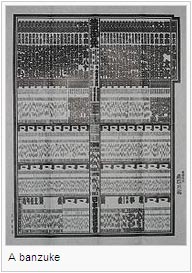 azukari
(預り) azukari
(預り)- Hold. A kind of draw. After a mono-ii,
the gyōji
or the shimpan
"holds" the result if it was too close to call.
In 1927, the system was abolished and a torinaoshi
(rematch) now takes place instead.
- banzuke
(番付)
- List of sumo wrestlers according to rank for a
particular grand tournament, reflecting changes
in rank due to the results of the previous tournament.
It is written out in a particular calligraphy (see
sumo-ji)
and released two weeks prior to the tournament.
- banzuke-gai
(番付外)
- Outsider to the list. A wrestler who is
not yet ranked, or has fallen off the banzuke
due to injury or other reason for non-participation.
- basho (場所)
- Venue. Any sumo tournament. Compare honbasho.
- chankonabe
(ちゃんこ鍋)
- A stew commonly eaten in vast quantity by sumo
wrestlers as part of a weight gain diet. It contains
dashi
or chicken stock with sake or mirin
to add flavor. The bulk of chankonabe is made up
of large quantities of protein sources, usually
chicken, fish (fried and made into balls), tofu,
or sometimes beef; and vegetables (daikon, bok choy,
etc).
- chikara-mizu
(力水)
- Power-water. The ladleful of water with
which a wrestler will ceremonially rinse out his
mouth prior to a bout, handed to him by either the
victorious wrestler of the previous bout if he was
on the same side of the dohyō, or by the wrestler
who will fight in the bout following.
- chonmage
(丁髷)
- Traditional Japanese haircut with a topknot, now
only worn by rikishi and so a easy way to
recognise that a man is in the sumo profession.
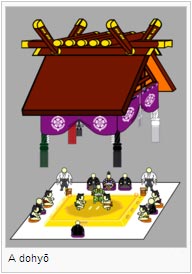
- danpatsu-shiki
(断髪式)
- Retirement ceremony, held for a top wrestler in
the Ryogoku
Kokugikan some months after retirement, in which
his chonmage,
or top knot is cut off. A wrestler must have fought
as a sekitori
in at least 30 tournaments to qualify for a ceremony
at the Kokugikan.
- dohyō (土俵)
- The ring in which the sumo wrestlers hold their matches, made of a specific clay and spread with sand. A new dohyō is built prior to each tournament.
- dohyō-iri (土俵入り)
- Ring-entering ceremony, performed only by jūryō and makuuchi divisions. The east and west sides perform their dohyō-iri together, in succession; the yokozuna have their own individual dohyō-iri performed separately. The main styles of yokozuna dohyō-iri are Unryū and Shiranui, named after Unryū Kyūkichi and Shiranui Kōemon. A yokozuna performs the ceremony with two attendants, the tachimochi (太刀持ち, sword carrier) and the tsuyuharai (露払い, dew sweeper).
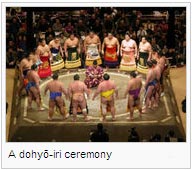 fusenpai
(不戦敗) fusenpai
(不戦敗)- No fight loss. The loss recorded by default
due to absence for a bout. If a wrestler withdraws
from the tournament, one fusenpai will be
recorded against him on the following day, and simple
absence for the remainder.
- fusenshō
(不戦勝)
- No fight win. A win by default due to absence
of the opponent. The system was established for
the honbasho
in the May 1927 tournament. After the issue of Hitachiiwa
Eitarō, the system was modified to the
modern form. Prior to this, an absence would simply
be recorded for both wrestlers, regardless of which
one had failed to show.
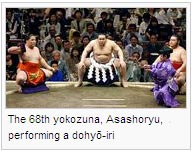 gunbai
(軍配) gunbai
(軍配)- A war fan, usually made of wood, used by the gyōji
to signal his instructions and final decision during
a bout. Historically, it was used by samurai officers
in Japan to communicate commands to their soldiers.
- gyōji
(行司)
- A sumo referee.
- hanamichi (花道)
- The two main east and west "paths" leading from
the preparation rooms to the dohyō.
- haridashi (張り出し)
- Overhang. If there are more than two wrestlers
at any sanyaku rank, the additional wrestlers
are termed haridashi. Prior to 1995, such
wrestlers were listed on the banzuke in extensions
or "overhangs" to the row for makuuchi wrestlers.
This is now an informal designation, since presently
all wrestlers are listed within the normal bounds
of the row.
- henka
(変化)
- A sidestep to avoid an attack. If done, it is
usually at the tachi-ai to set up a slap-down
technique, but this is often regarded as bad
sumo and unworthy of higher ranked wrestlers.
- heya
(部屋)
- Room, but usually rendered stable.
The establishment where a wrestler trains, and also
lives while he is in the lower divisions. It is
pronounced beya in compounds, such as in
the name of the stable. (For example, the heya
named Sadogatake is called Sadogatake-beya.)
- hikiwake (引分)
- Draw. It is very rare now.
- hiwaza (非技)
- Non-technique. A winning situation where
the victorious wrestler did not initiate a kimarite.
The Japan Sumo Association recognizes five hiwaza.
See kimarite
for descriptions.
- honbasho
(本場所)
- A professional sumo tournament, held 6 times a
year in the modern era, where the results affect
the wrestlers' rankings.
- ichimon (一門)
- A group of related heya.
There are five groups: Dewanoumi, Nishonoseki, Takasago,
Tokitsukaze and Tatsunami. Until 1965, wrestlers
from the same ichimon did not fight each
other in tournament competition.
- jo-jin
- High rankers. A term loosely used to describe
wrestlers who would expect to face a yokozuna
during a tournament. In practice this normally means
anyone ranked maegashira 4 or above.
- jonidan
(序二段)
- The second-lowest division of sumo wrestlers,
below sandanme and above jonokuchi.
- jonokuchi
(序の口)
- An expression meaning this is only the beginning.
The lowest division of sumo wrestlers.
- junyusho (準優勝)
- An informal designation for a second place finish
in a sumo championship.
- jūryō
(十両)
- Ten ryō,
for the original salary of a professional sumo wrestler.
The second-highest division of sumo wrestlers, below
makuuchi and above makushita, and
the lowest division where the wrestlers receive
a salary and full privileges.
- kachi-koshi
(勝ち越し)
- More wins than losses for a wrestler in a tournament.
This is 8 wins for a sekitori with 15 bouts
in a tournament, and 4 wins for lower-ranked wrestlers
with 7 bouts in a tournament. Gaining kachi-koshi
generally results in promotion. The opposite is
make-koshi.
- kadoban (角番)
- An ōzeki who has suffered make-koshi
in his previous tournament and so will be demoted
if he fails to score at least eight wins. The present
rules date from July 1969 and there have been over
100 cases of kadoban ozeki since that time.
- kensho-kin
(懸賞金)
- Prize money based on sponsorship of the bout,
awarded to the winner upon the gyōji's
gunbai. The banners of the sponsors are paraded
around the dohyō prior to the bout,
and their names are announced. Half the sponsorship
fees go to the Japan Sumo Association, and half
to the winner.
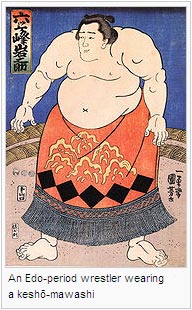 keshō-mawashi
(化粧廻し) keshō-mawashi
(化粧廻し)- The loincloth fronted with a heavily decorated
apron worn by sekitori wrestlers for the
dohyō-iri. These are very expensive,
and are usually paid for by the wrestler's organization
of supporters or a commercial sponsor.
- kimarite
(決まり手)
- Winning techniques in a sumo bout, announced by
the referee on declaring the winner. The Japan Sumo
Association recognizes eighty-two different kimarite.
- kinboshi (金星)
- Gold star. Awarded to a maegashira
who defeats a yokozuna during a honbasho.
It represents a permanent salary bonus.
- kinjite
(禁じ手)
- Forbidden hand. A foul move during a bout,
which results in disqualification. Examples include
punching, kicking and eye-poking. The only kinjite
likely to be seen these days (usually inadvertantly)
is hair-pulling.
- komusubi
(小結)
- Little knot. The fourth-highest rank of
sumo wrestlers, and the lowest sanyaku rank.
- kosho
seido (公傷制度)
- Public Injury System. Introduced in 1971,
this system allowed a wrestler who had been injured
in the ring during a tournament to sit out the next
tournament without any effect on his rank. It was
controversially abolished in 2003.
- kuroboshi (黒星)
- Black star. A loss in a sumo bout, recorded
with a black circle.
- maegashira
(前頭)
- Those ahead. The fifth-highest rank of
sumo wrestlers, and the lowest makuuchi rank.
This rank makes up the bulk of the makuuchi
division, comprising around 30 wrestlers depending
on the number in sanyaku. Only the top ranks
(maegashira jō'i, 前頭上位)
normally fight against sanyaku wrestlers.
- maezumo (前相撲)
- Before sumo. Unranked sumo wrestlers in
their first bouts. Participation in at least one
maezumo bout is required to enter the jonokuchi
division for the following honbasho.
- make-koshi
(負け越し)
- More losses than wins for a wrestler in a tournament.
Make-koshi generally results in demotion,
although there are special rules on demotion for
ōzeki. The opposite is kachi-koshi.
- makuuchi
(幕内) or maku-no-uchi (幕の内)
- Inside the curtain. The top division in
sumo. It is named for the curtained-off waiting
area once reserved for professional wrestlers during
basho, and comprises 42 wrestlers.
- makushita
(幕下)
- Below the curtain. The third highest division
of sumo wrestlers, below jūryō
and above sandanme. Originally the division
right below makuuchi, explaining its name,
before jūryō was split off from
it to become the new second highest division.
- makushita
tsukedashi (幕下付け出し)
- a successful amateur wrestler who is allowed to
enter pro sumo at the third highest division (makushita).
From 1966 until 2001 a rikishi would begin
at the rank of Makushita 60, the bottom of
the division. From 2001 this was raised to Makushita
15, but entry criteria were made stricter; a wrestler
now has to have won one of the four major amateur
titles. In the event of two victories in the same
year, he can begin at Makushita 10.
- mawashi
(廻し)
- The thick-waisted loincloth worn for sumo training
and competition. Those of sekitori wrestlers
are white cotton for training and colored silk for
competition; lower ranks wear dark cotton for both
training and competition.
- mochikyukin
(持ち給金)
- A system of bonus payments to wrestlers.
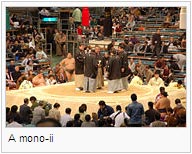 mono-ii
(物言い) mono-ii
(物言い)- The discussion held by the shimpan when
the gyōji's decision for a bout is called
into question.
- mushōbu
(無勝負)
- No result. A kind of draw. The Gyoji
doesn't judge win-loss. The system existed in Edo
period.
- negishi-ryu
(根岸流)
- The conservative style of calligraphy
used in the banzuke. See sumo-ji.
- Nihon
Sumo Kyokai (日本相撲協会)
- Japan
Sumo Association, the governing body for professional
sumo.
- oyakata (親方)
- A sumo coach, almost always the owner of one of
the 105 name licenses (toshiyori-kabu, 年寄株).
Also used as a suffix as a personal honorific.
- ōzeki
(大関)
- Great barrier, but usually translated Champion.
The second-highest rank of sumo wrestlers.
- rikishi (力士)
- Literally, Strong man. The most common
term for a professional sumo wrestler, although
sumotori is sometimes used instead. See 力士
in Japanese.
- sagari (下がり)
- The strings inserted into the front of the mawashi
for competition. The sagari of sekitori
wrestlers are stiffened with a seaweed-based glue.
- sandanme
(三段目)
- Third level. The third lowest division
of sumo wrestlers, above jonidan and below
makushita.
- sanyaku (三役)
- Three ranks. The "titleholder" ranks at
the top of sumo. There are actually 4 ranks in sanyaku:
yokozuna,
ōzeki,
sekiwake
and komusubi,
since the yokozuna is historically an ōzeki
with a license to perform his own ring-entering
ceremony. The word is occasionally used to refer
only to sekiwake and komusubi.
- sanyaku
soroibumi (三役揃い踏み)
- Ritual preceding the final three bouts of a honbasho
day where three of the sanyaku-ranked wrestlers
from the east and west sides in turn perform shiko
simultaneously.
- sekitori
(関取)
- Taken the barrier. Sumo wrestlers ranked
jūryō
or higher.
- sekiwake
(関脇)
- The third-highest rank of sumo wrestlers.
- shikiri (仕切り)
- Toeing the mark. The preparation period
before a bout, during which the wrestlers stare
each other down, crouch repeatedly, perform the
ritual salt-throwing, and other tactics to try and
gain a psychological advantage.
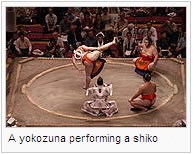 shiko
(四股) shiko
(四股)- The sumo exercise where each leg in succession
is lifted as high and as straight as possible, and
then brought down to stomp on the ground with considerable
force. In training this may be repeated hundreds
of times in a row. Shiko is also performed
ritually to drive away demons before each bout and
as part of the yokozuna dohyo-iri.
- shikona
(四股名)
- A wrestler's "fighting name", often a poetic expression
which may contain elements specific to the wrestler's
heya. Japanese wrestlers frequently do not
adopt a shikona until they reach makushita
or jūryō; foreign wrestlers adopt
one on entering the sport. On rare occasions, a
wrestler may fight under his original family name
for his entire career.
- shimpan
(審判)
- Ringside judges or umpires who may issue final
rulings on any disputed decision. There are five
shimpan for each bout, drawn from senior
members of the Nihon Sumo Kyokai, and wearing
traditional formal kimono.
- shimpan-iin
(審判委員)
- Umpire committee. The shimpan as
a group.
- shin-deshi
(新弟子)
- New pupil. A new recruit into sumo.
- shini-tai
(死に体)
- Dead body. A wrestler who was not technically
the first to touch outside the ring but is nonetheless
ruled the loser, for example when he is pushed out
with such force that he is still in the air when
his opponent touches down.
- shiroboshi
(白星)
- White star. A victory in a sumo bout, recorded
with a white circle.
- sumo-ji (相撲字)
- Calligraphy style with very wide brushstrokes
used to write the banzuke.
 sumo
moji (相撲文字) sumo
moji (相撲文字)- See sumo-ji.
- sumotori (相撲取)
- Literally, One who does sumo. Sumo wrestler,
but occasionally refers only to sekitori.
- tachi-ai
(立ち合い)
- The initial charge at the beginning of a bout.
- tawara (俵)
- Bales of rice straw. Tawara are half-buried
in the clay of the dohyō to mark its boundaries.
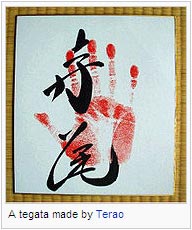 tegata
(手形) tegata
(手形)- A type of memorabilia consisting of a wrestlers
handprint in red or black ink and his shikona
written by the wrestler in calligraphy on a square
paperboard. It can be an original or a copy. A copy
of a tegata may also be imprinted onto other
memorabilia such as porcelain disshes.
- tenno-hai
(天皇杯)
- Emperor's Cup, awarded to the winner of the top
division tournament championship since 1925.
- tokoyama
(床山)
- Hairdressers employed by the Sumo
Association to style the hair of sekitori
wrestlers into the elaborate oichomage
for official tournaments and public engagements.
- torikumi (取組)
- A bout during a basho.
- torinaoshi
(取り直し)
- A rematch. When the result of a bout is too close
to call even after the shimpan hold a mono-ii,
they may call for the bout to be refought from the
tachi-ai.
- toshiyori
(年寄)
- A sumo elder.
- tsukebito (付け人)
- A rikishi in the lower divisions who serves
as a personal attendant to a sekitori
ranked wrestler.
- tsuna (綱)
- The heavy rope worn by the yokozuna from
which that rank takes its name. It weighs about
15 kg, and is much thicker in front than where it
is tied in back. Five shide
(紙垂), zig-zag paper strips symbolizing
lightning, hang from the front. It strongly resembles
the shimenawa
used to mark sacred areas in Shinto.
- yobidashi
(呼出 or 呼び出し)
- Announcer. General assistants at basho.
They call the wrestlers to the dohyō
before their bouts, build the dohyō
prior to a tournament and maintain it between bouts,
display the advertising banners before sponsored
bouts, maintain the supply of ceremonial salt and
chikara-mizu, and any other needed odd jobs.
- yokozuna
(横綱)
- Horizontal rope. The top rank in sumo,
usually translated Grand Champion. The name
comes from the rope a yokozuna wears for
the dohyo-iri. See tsuna.
- Yokozuna
Shingi Kai (横綱審議会)
or Yokozuna Shingi Iinkai (横綱審議委員会)
- Yokozuna Deliberation Council, a body formed
in 1950 whose 15 members are drawn from outside
the Japan Sumo Association, that meets following
each honbasho to consider candidates for
promotion to yokozuna. A recommendation is
passed back to the Sumo Association who have the
final say. It also offers opinions on the performance
of current yokozuna.
- yumitori-shiki
(弓取り式)
- The bow-twirling ceremony performed at the end
of each honbasho day by a designated wrestler,
the yumitori, who is usually from the makushita
division.
- yūshō
(優勝)
- A tournament championship in any division, awarded
to the wrestler who wins the most bouts.
See all sports glossaries:
Published - January 2009
This
glossary is available under the terms
of the GNU Free Documentation
Find free glossaries at TranslationDirectory.com
Find free dictionaries at TranslationDirectory.com
Subscribe to free TranslationDirectory.com newsletter
Need more translation jobs from translation agencies? Click here!
Translation agencies are welcome to register here - Free!
Freelance translators are welcome to register here - Free!
Submit your glossary or dictionary for publishing at TranslationDirectory.com
|